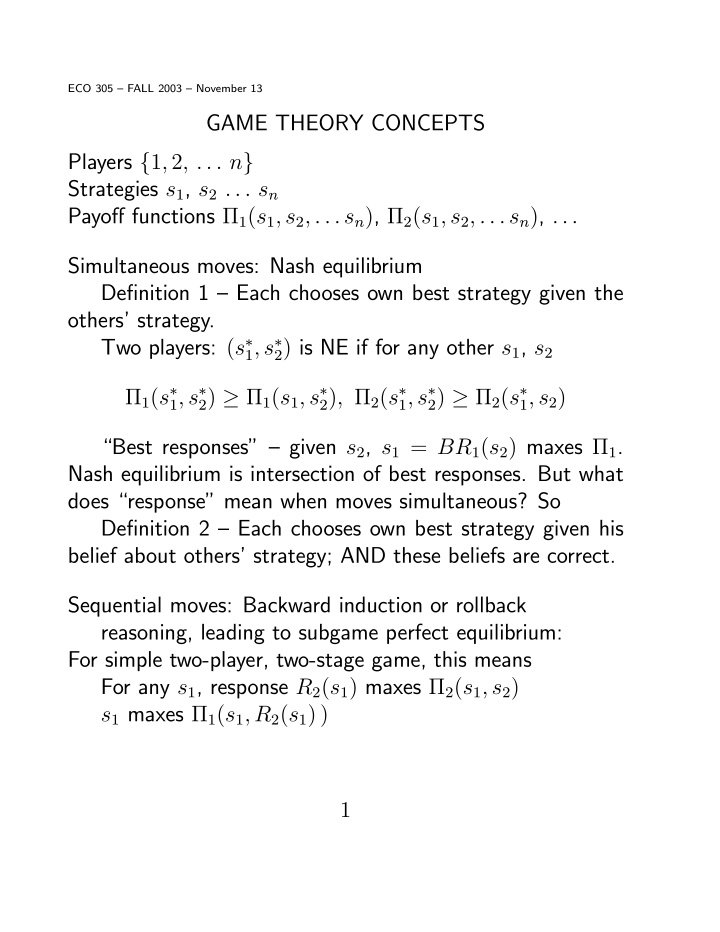



ECO 305 — FALL 2003 — November 13 GAME THEORY CONCEPTS Players { 1 , 2 , . . . n } Strategies s 1 , s 2 . . . s n Payo ff functions Π 1 ( s 1 , s 2 , . . . s n ) , Π 2 ( s 1 , s 2 , . . . s n ) , . . . Simultaneous moves: Nash equilibrium De fi nition 1 — Each chooses own best strategy given the others’ strategy. Two players: ( s ∗ 1 , s ∗ 2 ) is NE if for any other s 1 , s 2 Π 1 ( s ∗ 1 , s ∗ 2 ) ≥ Π 1 ( s 1 , s ∗ 2 ) , Π 2 ( s ∗ 1 , s ∗ 2 ) ≥ Π 2 ( s ∗ 1 , s 2 ) “Best responses” — given s 2 , s 1 = BR 1 ( s 2 ) maxes Π 1 . Nash equilibrium is intersection of best responses. But what does “response” mean when moves simultaneous? So De fi nition 2 — Each chooses own best strategy given his belief about others’ strategy; AND these beliefs are correct. Sequential moves: Backward induction or rollback reasoning, leading to subgame perfect equilibrium: For simple two-player, two-stage game, this means For any s 1 , response R 2 ( s 1 ) maxes Π 2 ( s 1 , s 2 ) s 1 maxes Π 1 ( s 1 , R 2 ( s 1 ) ) 1
Example of simultaneous-move game Top 3 2 10 High 4 3 6 Row Low 2 5 12 Bottom 4 5 9 Example of sequential-move game Honor 1 , 1 contract Renege - 1 , 3 Megacorp 0 , 0 Our economic application will have continuously variable strategies (price etc.) 2
QUANTITY-SETTING (COURNOT) DUOPOLY Π 1 ( x 1 , x 2 ) = ( p 1 − c 1 ) x 1 = [( a 1 − c 1 ) − b 1 x 1 − k x 2 ] x 1 Firm 1’s best response ( a 1 − c 1 ) − 2 b 1 x 1 − k x 2 = 0 Similarly fi rm 2’s. Solve jointly for Cournot-Nash eqm: x n [ 2 b 2 ( a 1 − c 1 ) − k ( a 2 − c 2 ) ] / (4 b 1 b 2 − k 2 ) = 1 x n [ 2 b 1 ( a 2 − c 2 ) − k ( a 1 − c 1 ) ] / (4 b 1 b 2 − k 2 ) = 2 3
STABILITY — RATIONALIZABILITY STACKELBERG LEADERSHIP Sequential: fi rm 1 chooses x 1 ; then fi rm 2 chooses x 2 4
COURNOT OLIGOPOLY Homog. product, n identical fi rms Constant marg. cost c , fi xed cost f for each Linear industry demand : p = a − b X Firm i pro fi t: Π i = [ a − b ( x 1 + x 2 + . . . + x n )] x i − c x i − f FONC : a − b ( x 1 + x 2 + . . . + x n ) − c − b x i = 0 Adding FONCs : n [ a − b X − c ] − b X = 0 . Solution for eqm. n a − c 1 a − c p = a + n c X = , x = , n + 1 b n + 1 b n + 1 As n ↑ ∞ , p ↓ c (competitive limit). But max n compatible with Π > 0 n ≡ a − c √ b f − 1 5
PRICE-SETTING (BERTRAND) DUOPOLY Pro fi t Π 1 ( p 1 , p 2 ) = ( p 1 − c 1 ) ( α 1 − β 1 p 1 + κ p 2 ) Best response p 1 = [ ( α 1 + β 1 c 1 ) + κ p 2 ] / (2 β 1 ) COMPARISONS For substitute products, ranked by Prices ↑ , Quantities ↓ , Firms’ pro fi ts ↑ , Cons. surplus and Social e ffi ciency ↓ 1. Marginal cost pricing 2. Bertrand 3. Cournot 4. Cartel (Joint pro fi t max) 6
Recommend
More recommend